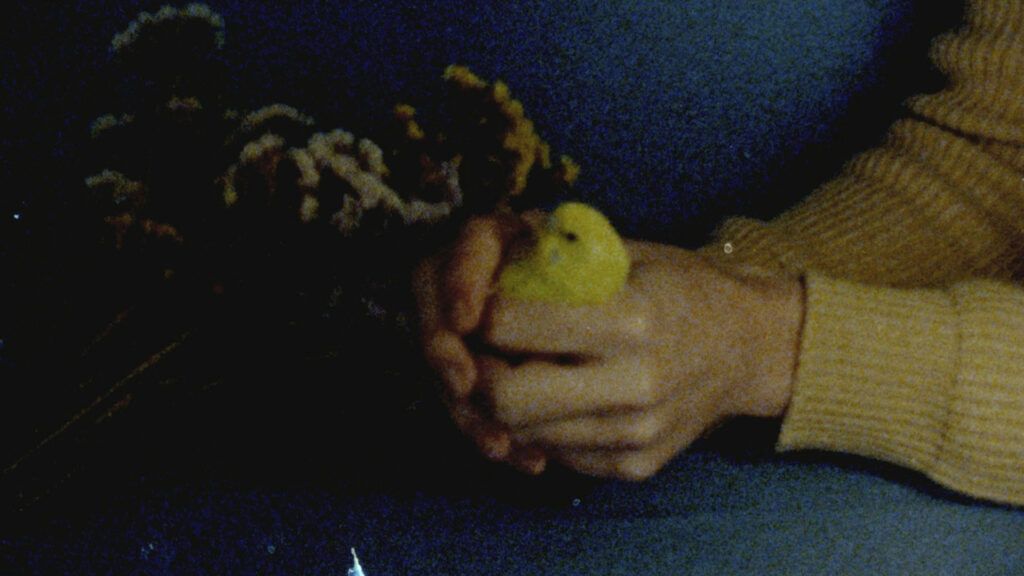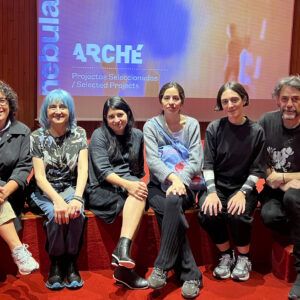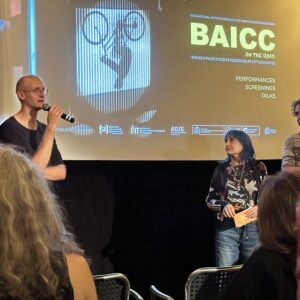
With the clear vision of cinema that inspires us, and the importance of appreciating and giving space to the past and to international creators, through (S8) we also realise the urgent need to bring together the people who are creating here and now, and to open up new universes to future generations (the latter through Paraíso). That is where the idea of broadening Sinais came from, a task that has finally extended the section to three programmes on account of an emerging panorama of creation that has ended up overflowing.
In the first session, we are grouping together the works with more plastic, formal roots. As for the use of celluloid, the session opens with a film-performance by Aura Vega: 16mm cinema made without a camera encounters writing and language here, turning obsessive annotation into an abstract game. Álvaro Feldman brings two studies in Super 8 that arise from experimentation with optical and lighting techniques: on the one hand, the dampening mixture of colours of light, and on the other, the use of in-camera masking, creating a kind of collage. Saru Miras, for her part, takes the structural experiment of filming frame-by-frame to the extreme, using kilometres, metres and centimetres as a metric guide, in a piece that ends up also revealing itself to be a diary-type, intimate exercise. Like Inês Lima, Miras films a piece in Super 8 in which the artisanal development and articulation of colours in her enigmatic images are in tune with the evocation of the text. Carla Andrade’s photographic education, on the other hand, leads us to a piece in which she mixes many formats to portray the landscape (in motion and still) and to reveal its telluric forces. Andrade’s sea is touched with the watery sensibility of the pieces Claudia Pineda and Acacia Ojea: the former, experimenting with underwater images (sometimes on a double screen), and Ojea with skin-deep sensoriality and human gestures.
The second session follows a path more closely linked to non-fiction cinema. There are Super 8 impressions that border on the ethnographic, as is the case with the piece by Jaione Comborda Coll, a brief vision of the Galician countryside, and in the case of La Tarara, by Álvaro Feldman, which portrays a family from a neighbourhood in Seville using an exciting and emotional diary-like register. Descartes (Discards) by Alejandro Alvarado and Concha Barquero, and O cinquito (con derecho a tocar) by nucbeade, investigate more-or-less shameful episodes in recent history: the first recalls the post-Franco censorship of the film Rocío by Fernando Ruiz Vergara, through its discards, and the second recalls the exhibiting of human beings as phenomena in fairground stalls. Finally, Helena Estrela humourously portrays the anguish of youth in the pandemic in a succession of mises-en-scène reminiscent of the cinema of Benning or Lertxundi.
The last session is video and digital in nature, with the neon colours of our time. It opens with the performance/installation proposal by Claudio Sodi and his phosphorescent film, which diverts one’s gaze from the screen, taking it towards the projector. There are bright colours, like those in Los apellidos (The surnames) by Tamara Goberna, who with a host of video manipulations deforms the image, exploits it and multiplies it in an exercise based on depersonalisation. The idea of clandestine records comes to mind in the pieces by María Pipla and Sol Mussa. In Metro, Pipla makes use of a found family tape in which a fortuitous mistake (accidentally recording footage on the underground train) ends up serving for a Perfect Film like Jacobs’ one. Mussa looks again at the capitalist underworlds and back rooms, this time through a sordid nocturnal view of the routes that the rubbish we produce follows every day. The feeling of the times and the meaning of creating through stark intimacy is evident in the pieces by Marta Valverde and Claudia Negro. Valverde focuses on the precariousness of subsistence in the art world, placing it in parallel with the world of prostitution, wondering where the greatest violence is to be found. Finally, Claudia Negro makes use of the codes and languages of the Internet: social networks, WhatsApp, Google and Youtube no longer exist in a parallel dimension to life, but are a part of it. Negro’s multi-screen film is the closest thing to an experience of the world that we have. Through intimacy it talks of the angst specific to this generation, but also of the one that comes from time immemorial: the vulnerability and strength of youth.





